
Matrix | What is Matrix?
A matrix is a rectangular array of
numbers arranged in horizontal and vertical lines and enclosed between round or
square brackets. Horizontal lines are called rows and vertical lines are called
columns of a matrix.
********************
10 Math Problems officially announces the release of Quick Math Solver and 10 Math Problems, Apps on Google Play Store for students around the world.
********************
********************
Some examples of the matrix are given below:
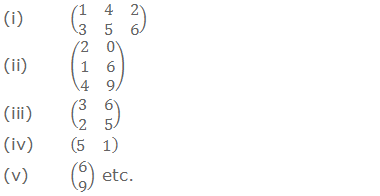
Each member or number in the array is
called an element or an entry of the matrix. An element appearing in the ith
row and jth column of a marix is called its (i, j)th
element or the (i, j)th entry.
Order of a Matrix
The order or the size of the matrix is
given by the number of rows followed by the number of columns. If a matrix
contains m rows and n columns, then it is of order m × n, read as m by n.

Matrix Notation
The matrices are usually denoted by capital
letters such as A, B, C, ………etc. The elements are denoted by the corresponding
small letters along with two suffixes. The first suffix indicates the number of
row and latter one indicates the number of column in which the element appears.
aij is the element of a matrix A in the
ith row and jth column.
a23 is the element of a matrix A in the
2nd row and 3rd column.
Thus a matrix of order m × n may be written as
A = (aij)m × n
If A is a 3 × 3 matrix, then it may be written as

Types of Matrices
1. Row Matrix:

2. Column Matrix:
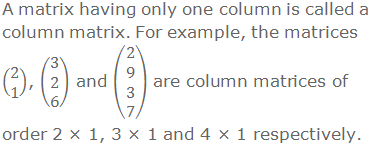
3. Square Matrix:
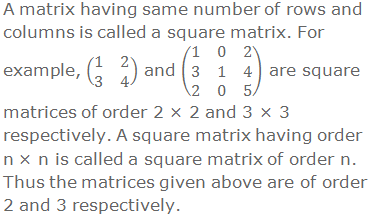
4. Rectangular Matrix:
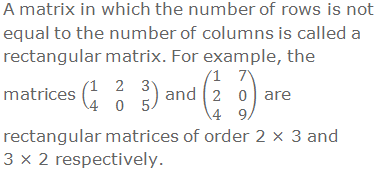
5. Zero Matrix or Null Matrix:
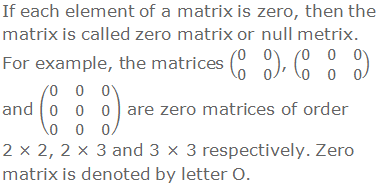
6. Diagonal Matrix:
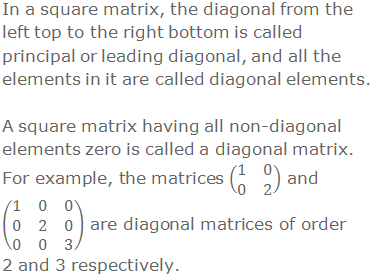
7. Scalar Matrix:
![Scalar Matrix If all the diagonal elements of a diagonal matrix are same, then the matrix is called a scalar matrix. For example, the matrices (■(5&0@0&5)) and (■(-2&0&0@0&-2&0@0&0&-2)) are scalar matrices of order 2 and 3 respectively. [Note that a scalar matrix is a particular case of a diagonal matrix.]](https://blogger.googleusercontent.com/img/b/R29vZ2xl/AVvXsEj78ycG5sL0XrO1Rdleg9uN8OlAfu8Hx07UAuMcm4HSf8lcrtEuqq3V2-aHYoKFlVnFWOKjjszD9CfJDksILQSuZE069UymnhqOnq1fqF261sqqj5hrbKfvZq1sDoyjasQJ1_EuCpxSGyNC/s16000/7.+Scalar+Matrix.png)
8. Unit Matrix or Identity
Matrix:
![Unit Matrix or Identity Matrix If all the diagonal elements of a diagonal matrix are unity, then the matrix is called an identity or unit matrix. For example, the matrices (■(1&0@0&1)) and (■(1&0&0@0&1&0@0&0&1)) are unit matrices of order 2 and 3. An Identity Matrix is denoted by the letter I. [Note that a unit matrix is a particular case of a scalar matrix.]](https://blogger.googleusercontent.com/img/b/R29vZ2xl/AVvXsEjnzLLDMZO2A8i3gHyIRVUrsGwivZFBOABZ3ibvokrb0AVWzT3RVVmiLD6lgqCHv2uYPAw1QIfAfbIk4EPgelLnoOfeZh2oOVWyR5UNL8V_6jH64DWJdoVZ6A0fdOpdDb1HYHr0qKUud7Jk/s16000/8.+Unit+Matrix+or+Identity+Matrix.png)
Equal Matrices
Two matrices A and B are said to be equal matrices
if A and B are of same order i.e. number of rows in A = number of rows in B and
number of columns in A = number of columns in B, and their corresponding
elements are equal i.e. the entries of A and B in the same position are equal.
Otherwise, the matrices are said to be unequal.
If A and B are equal matrices, then we write A =
B. Otherwise, we write A ≠ B.
For example:
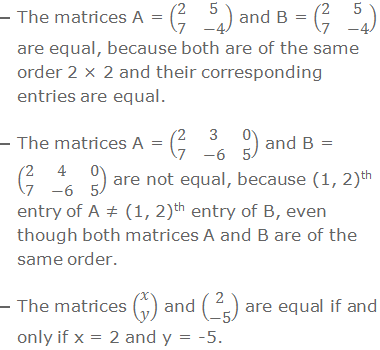
Worked Out Examples
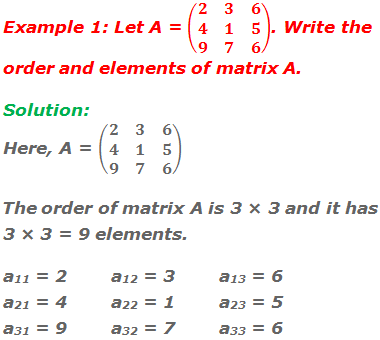
Example 2: If a matrix has 6 elements, what are the possible orders
it can have?
Solution:
If a matrix has 6 elements, then it can have any one of the
following orders:
1 × 6, 6 × 1, 2 × 3 or 3 × 2.
Example 3: Construct a 2 × 2 matrix whose elements aij
are given by aij = i + j.
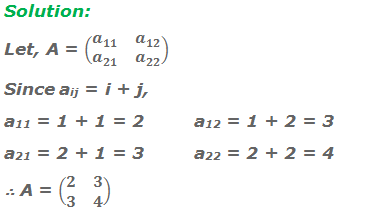
Example 4: Construct a 2 × 2 matrix A whose element aij
are given by aij = 3i + 2j.
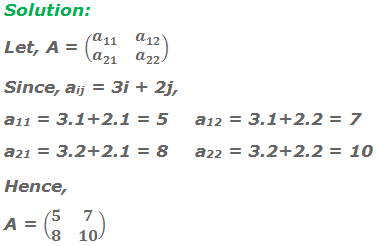
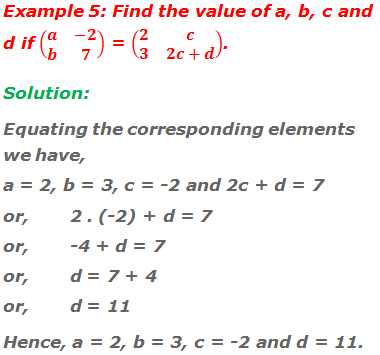
Do you have any questions regarding the matrix?
You can ask your questions or problems here, in the comment section below.



0 comments: